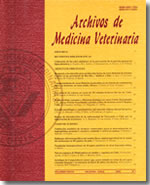Meta-analysis of the effect of low protein diets for finishing barrows
Main Article Content
Abstract
A meta-analysis was carried out using individually pig data from seven experiments involving 222 hybrid finishing pigs with initial body weight of 52.69 ± 3.74 kg, individually housed, fed low-protein diets. Growth performance, carcass characteristics and plasma urea nitrogen concentration were evaluated. An analysis of variance and regression using a response surface model with RSREG procedure of SAS (2009) were performed considering level of crude protein (CP), effect of the experiment, year, time of year, type and level food additive supplemented. Optimum levels of CP were determined (12.8, 11.3 and 9.5%) and corroborated through an additional experiment using 36 hybrid finishing pigs with 54.01 kg of initial weight, during 42 days. Average daily gain, daily feed intake, feed conversion, final weight, gain lean meat, lean meat percentage, longissimus muscle area and plasma urea nitrogen concentration were not affected (P > 0.05) at a concentration of 11.5% CP, however, with 9.5% PC these variables were affected (P ≤ 0.05); backfat increased by lowering CP (P ≤ 0.05). In the experiment to corroborate optimal levels of PC, there were no differences (P > 0.05) for weight gain, feed intake, final weight and gain lean to lower the PC diet to 11.5%. For backfat, longissimus muscle area and lean meat percentage there were no differences (P > 0.05) when decreasing prot to 12.8 9.5% PC. Plasma urea concentration was lowered (P ≤ 0.05) to decrease the PC diet. Reducing dietary protein to 11.5% does not adversely affect the variables analysed.

